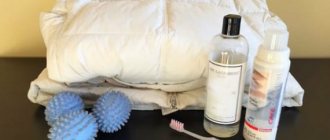It's no secret that washing black and white clothes at the same time is undesirable. This treatment can cause damage to light-colored fabrics. The products take on a gray tint and dark spots and stains may appear on them.
If it is impossible to refuse co-washing, then measures must be taken to allow the procedure to be carried out with minimal losses.
Is it possible to wash black and white, what will happen to things after washing them together? What to do if the items fade after being washed together, how to bleach white? Find answers to your questions in the article.
What things are painted most often?
What sheds first:
- new clothes;
- jeans;
- jackets;
- bright things, especially red, orange, green, black, brown and blue;
- synthetics.
What is most susceptible to staining when washing:
- white fabric of any composition;
- natural fabrics;
- anything that was washed with lightly dyed colored clothing.
Crystal white things should not be washed even with light beige, gray, or pink. There is always a risk of slight staining. And especially do not wash white with red and black, even if dark things have never faded before.
Long jacket
If you love elegant yet warm looks, choose the longer version just above/below the knee. Thanks to this length, outerwear can be combined with any option: three-piece suit, floor-length dresses, pencil skirts and blouses.
To make it clear what to wear with a black long jacket, we have compiled a list of basic elements:
- pencil skirt;
- mini skirt;
- leggings;
- skinny jeans;
- straight trousers.
Separately, we need to talk about color combinations. You can wear any colored outfits and bright accessories under a black top. For footwear, white sneakers, sneakers, pumps, boots or ankle boots will be popular.
Emergency recovery
The first thing many housewives do immediately after discovering stains is to put things in the drum again. That's right, try adding more powder or gel, as well as oxygen bleach. An alternative is to rub the wet item with a bar of laundry soap and let it sit for half an hour and then wash it.
Rules for washing black clothes
The most common table salt will help maintain a bright and rich black color during washing.
It’s not for nothing that black is considered the most capricious color in terms of washing. How to wash black clothes? To do this, we can recommend using a special powder, or folk remedies - salt (table salt), alum, 9% vinegar.
You can wash black items either by hand or in a machine. In the case of machine washing, it is important to remember one rule: the less the drum is loaded, the better. Of course, only black clothes should be loaded into the drum. Items made from thin, delicate fabrics are recommended to be washed by hand.
We save things depending on the type of fabric
Natural cotton and linen items can withstand hot water, powerful bleach and even boiling. But these radical methods are absolutely not suitable for synthetics and openwork products.
Tip Aggressive spinning in the drum is one of the reasons for quickly washing out paint from fabrics. Set the minimum speed. The higher the friction, the greater the risk of shedding. It is for this reason that matter of different composition and density is sorted.
Natural fabrics
First, repeat the machine wash, but with more powder. Another option is to soak in hot water and bleach. If it doesn’t help, then start boiling. This is the slow heating of a solution with a bleaching component. The procedure lasts no more than half an hour.
Synthetic fabrics
Boiling is absolutely not suitable for synthetics, and even washing in hot water will only worsen the situation. To correct staining, use cool water and a gentle bleach.
Silk, wool, delicate fabrics
Take care of wool, silk and other delicate items in the same way as synthetics. Treat expensive fabrics like cashmere like royalty: wash strictly separately and only according to the instructions on the label.
Choice of product
For dark colors, it is recommended to choose products marked “For Black”. Such products are created on the basis of formulas that help the fabric not fade. Products are cleaned using powders (Aist Black, Proprete Black & Dark, Sano Maxima Black) and gels (Laska 3D, Burti Noir, Perwoll black Renew).
Light colors are processed using products containing bleaching components. Popular powders include PERSIL PREMIUM, LION BEAT ECONO MAX. Whitening gels include BIOMIO BIO-2B1, ATTITUDE MOUNTAIN ESSENTIALS 2 IN 1. GARDEN KIDS powder containing silver ions is suitable for children's underwear.
Advice! If contrasting items are washed together, it is worth using neutral substances. For this treatment, mild products without bleaching compounds are suitable.
Special equipment
If repeated washing with lots of soap or powder does not work, move on to more powerful measures. Hardware stores are pleased to offer bleaches with universal characteristics. Let's look at the most popular products and categories.
Antilin
This product is suitable for both white and colored items if they are painted with someone else’s shade. The original color is retained. Can be used for both machine and hand washing.
Bleach
A number of manufacturers from Vanish to Synergetic offer bleaches based on oxygen and optical brightening particles.
The obsolete component chlorine is still used. Products containing it are cheap, but their negative effect on materials requires increased care.
Stain remover
An alternative for dyed items is stain remover. You should not bleach pink or beige; instead of paint stains, faded areas will appear. Look for bottles marked “color.”
Powder + bleach
Some powders contain whitening granules. It is very comfortable. You can wash not only dyed items, but also ordinary ones - to prevent and preserve whiteness.
At home, try whitening methods one at a time, do not mix several types of household chemicals at once, wanting to speed up the result. Unexpected reactions are possible, and the clothes will deteriorate completely. Before trying a new product, rinse the test clothing thoroughly.
How to whiten a white collar or other contrasting elements on a black dress?
You can whiten a textured collar on a black dress not only through targeted action on a specific detail, but also directly in the process of everyday washing. If the traditional option of preserving color using vinegar does not give the desired result, you should try one of the following methods:
These options will not have the desired effect on a faded item. The traditional way to remove unaesthetic marks and stains will also not work. But before turning to professionals for help, you can try several options for restoring the product at home.
Traditional methods
Often, improvised products turn out to be no worse than expensive bleaches. The main thing is to apply them on time and in the right concentration. Just follow the recommendations for the type of fabric.
White
We recommend avoiding “Whiteness”, as it weakens the fibers and, if overused, causes grayness and deformation.
The product will come in handy if thick natural fabrics made of cotton, such as sheets, are heavily dyed and cannot be cleaned with anything. This chlorine bleach is used for soaking in cold water. “Whiteness” disinfects fabrics and removes greasy stains - a nice bonus.
How to restore snow-white color:
- Use protective gloves; chlorine corrodes the skin of your hands.
- For 4 l - 1 tbsp. l. "Whiteness." This is a soaking solution and lasts 15 minutes.
- Rinse clothes thoroughly afterwards.
Boric acid
Boric acid will save the most delicate white items if they have become dyed during washing. Take 1 tbsp. l. acid per 2 liters of water.
This is the best way to soak socks, T-shirts, baby clothes and underwear. Boric acid destroys fungus - a useful property for fabrics that cannot be washed in hot water.
Laundry soap + boiling
In the first case, after an unsuccessful wash, we urgently rubbed the entire fabric with a bar. Give laundry soap a second chance if your thick cotton item is damaged:
- Grate the block.
- Pour water into a pan, add soap, stir.
- Place the dyed item in the solution and start heating it slowly.
- Boil over low heat for 20-30 minutes, stirring constantly.
- Let the solution cool slightly and remove the clothes. Hot water pulled the paint out of the fibers; all that was left was to rinse thoroughly.
Vinegar
Now it's time for delicate fabrics. Colorless table vinegar, strengthened with laundry soap, will quickly restore the white color:
- For 5 liters of water - 3 tbsp. l. vinegar and some soap shavings.
- Soak for a convenient time, possibly overnight.
Prepare the following solution: for every liter of water - 1 tbsp. l. soda Let the item sit in the warm mixture for several hours, and then wash it again, this time without dyeing fabrics.
Turpentine
Treatment with turpentine will prevent new cotton items from fading and losing their brightness. For 1 liter - 10 ml of product. Soak for half an hour. The same solution will be useful if things are painted.
Hydrogen peroxide
Peroxide will save any T-shirt, since, in fact, it is an oxygen bleach:
- For 4 liters of water - a 50 ml bottle of hydrogen peroxide.
- You can add washing powder.
- Soak affected clothing for an hour, then wash.
Tip Peroxide is suitable for boiling: 3 tbsp per pan is enough. l.
Ammonia
For 6 liters of water - 1 tbsp. l. ammonia. Immerse the painted fabric in the solution for half an hour.
Starch
Previously, housewives regularly starched white collars, sheets and other things. If you mix potato starch, lemon juice and a little grated laundry soap, and then treat the stains from the inside out, then after a couple of hours the usual whiteness of the fabric will be restored. The method is suitable for synthetics.
Potassium permangantsovka
The French way to whiten things:
- The solution is only slightly concentrated. A few permanganate crystals are enough for a basin of water so that the water is barely colored.
- Add powder and soak the item.
- Don't forget to rinse. An extra wash won't hurt.
Lemon juice
This citrus is useful not only for colds, but also for emergency treatment of faded items, including delicate items, wool and silk. Simply squeeze the juice out of the fruit and apply it to the stain from the inside out. After 1 hour, rinse, usually this time is enough to remove the paint.
Advice: Lemon juice is replaced with a solution of citric acid - 15 g per glass of water.
Restoring the color of a faded item
To restore the color of an item, you need to soak it in a solution of warm water with a stain remover. The procedure should last several hours
When choosing a stain remover, you need to pay attention to whether it is suitable for colored clothes
If such “resuscitation” does not bring results, you should soak in another solution - based on ammonia. To prepare it, you need to dilute warm water (5 l) with an aqueous solution of ammonium hydroxide (100 ml). Clothes should be kept in the resulting liquid for an hour, then rinsed thoroughly under plenty of water or washed as usual.
You can also use the following recipe to combat stains on clothes:
- 1 tbsp. l. starch;
- 30 g of laundry soap (shavings);
- 1 tsp. citric acid;
- 0.5 tbsp. l. salt.
It is necessary to mix all the ingredients and dilute them in water until it reaches a thick consistency. The mixture should be carefully rubbed into faded stains with a sponge. Next, the item should be left for half a day and washed with powder as usual.
You can wash a faded item using baking soda. To do this, you need to mix it with water to a paste-like state and apply it to the stains. After a third of an hour, the item needs to be washed.
Colored clothes can be boiled, but only if they are plain and made of high-quality material.
If denim has faded, its color can be restored with laundry soap. To do this, you need to thoroughly rub it into the stains and leave for half an hour. After this, the jeans should be washed as usual.
If the denim still cannot be saved, the item can be painted in a different, darker or lighter shade. To do this, you need to have a special fabric paint or regular blue.
How to prevent staining
Preventing staining of fabrics is easier than removing stains. This is a truism familiar to every housewife. Especially the one who had to urgently bleach stains from her clothes.
Sorting
This is the basic rule. We sort not only by color (white, light, different colors, black), but also by the composition of the material. Natural linen with synthetics cannot be washed.
We wash new items separately
Introduce new clothes to water and powder as carefully as possible and separately from other things: we don’t know how the fabric will behave. The examination can be carried out in a separate small area. Wet the edge of the fabric with warm water and see what happens.
Temperature
Even items washed several times can suddenly fade due to hot water. It's simple: the higher the washing temperature, the easier the paint particles are washed out.
Wash certain items by hand
Inspect the details of the clothing carefully: even stripes, pocket lining or collars may fade, leaving stains on lighter areas. Treat such items in cold water and quickly; do not soak them for a long time.
Note color fixing tricks: vinegar and salt solution for pre-soaking. Special washing conditioners will help restore the brightness and color of dyed clothes.
Tip How to wash a black dress with a white collar: soak the item briefly in soapy water, wash, rinse and wring out. Then lay it out on a flat surface and apply the bleach solution strictly to the collar. After 15-20 minutes, rinse the dress completely again and send to dry.
Don't delay rescuing faded clothes
The most important rule for damaged clothes: start bleaching immediately while they are still wet. Usually stains are noticeable immediately after removing items from the drum. Always inspect your clothes after washing. Any old stain is much more difficult to deal with than a fresh one.
Source of the article: https://gidpotkanyam.ru/belaya-odezhda-okrasilas-pri-stirke.html
Is it possible to wash black and white, what will happen to things when washed together, what to do if clothes are faded and how to bleach them, How to wash a white item if it was washed with black.
How to wash black and white clothes - choosing a detergent
The only thing that will allow you to cope with this difficult task in cool water is a gel for washing colored items. But you also need to choose it wisely:
- the gel should be intended for the care of colored items - it contains specific stabilizers that fix the color and maintain its contrast;
Important! How to wash a black and white dress or other item if there is a stain on the white part? In this case, use the local washing method. Choose a suitable stain remover: you will read more about this in our article “How to remove difficult stains.”
Next, treat the stain with it, having previously secured all the black parts, for example, place several folds of wide polyethylene under the stain and treat the stain only within its limits, avoiding spreading. After treatment, the area should be rinsed thoroughly, being careful not to wet the fabric around it.
To ensure you are only pleased with the washing result, use Wellery DELICATE Color washing gel for colored items.
Wellery DELICATE Color:
- washes colored, including black and white, items made from all fabrics, except silk and wool;
- Suitable for machine and hand washing;
- fixes the color and gives it brightness, prevents molting;
- washes well in water +30 °C;
- rinses completely, leaving no streaks, stains, or chemical traces hazardous to health;
- does not contain phosphates;
- It smells pleasantly and subtly of the freshness of a flower.
How to wash black and white and is it possible to avoid shedding and other problems?
It's no secret that washing black and white clothes at the same time is undesirable. This treatment can cause damage to light-colored fabrics. The products take on a gray tint and dark spots and stains may appear on them.
If it is impossible to refuse co-washing, then measures must be taken to allow the procedure to be carried out with minimal losses.
Is it possible to wash black and white, what will happen to things after washing them together? What to do if the items fade after being washed together, how to bleach white? Find answers to your questions in the article.
Consequences of washing contrasting laundry
It’s convenient if you have a lot of same-color items in your wardrobe: they can be washed together. But what if you need to wash one purple blouse, two burgundy T-shirts, blue jeans and white socks? It is irrational to wash one item at a time, and general washing can lead to disastrous consequences: brown, dark blue, or greenish stains will appear on light fabric.
To avoid troubles, it is better to know in advance which shades go together and which ones are best separated. The table shows shade options that can and cannot be washed together.
Some colors can be combined
Table 2. Combined and incompatible things
| Can | It is forbidden |
| Black and gray | White with any colored fabrics |
| Yellow with orange | White with gray |
| Red with pink | Red with black |
| Blue with green | |
| Blue with black |
Is it possible to wash together, what will happen to the clothes?
Sometimes situations arise in which it is impossible to avoid washing black and white items. Therefore, every housewife should know the secrets that will help prevent black fabric from shedding. Read more about washing black items here.
When is it allowed?
You can wash white and black items together as an exception in the following situations:
- Dark fabrics have been washed many times. The older the item, the less likely it is that the dye contained in its fibers will wash out.
- There will be a quick wash to refresh the fabric.
- There is no need to use aggressive detergents.
- Joint spinning will not take place.
You can wash black and white fabrics at the same time only in a gentle cycle, without soaking.
When is it prohibited?
It is necessary to avoid the combined processing of white and black fabrics in the following cases:
- The black item is new and has never been in contact with water. Even if the item is permanently dyed, it will still fade the first time you wash it.
- Soaking ahead. The longer the product is in water, the more dye will come out of its fibers.
- Requires processing at high temperatures. The hotter the water, the more actively the fabric sheds.
- Black fabric stains heavily. This is not difficult to understand. It is enough to moisten it, wrap it in a light cloth, rub it and leave for 5 minutes. If dark marks appear on the fabric, do not wash it together.
How to process in the washing machine at the same time?
If it is impossible to refuse co-washing in an automatic machine, then you need to act according to the following instructions:
- Turn all products inside out.
- Pack items into laundry bags. Black products are placed in one grid, and light ones in the other.
- Select a washing program. Optimal indicators: water temperature – up to 30 degrees, spin switched off, cycle duration – no more than an hour.
As a rule, these parameters correspond to a delicate or gentle washing mode, as well as the “wool” and “silk” programs.
- Add detergent. It should be gentle. The less surfactant content it contains, the better. Preference is given to liquid formulations and gel capsules. You can use baby powder.
- Start the program, wait for it to complete, immediately after the beep, remove the items and send them to dry.
Rules for caring for black products
Before you start washing in the washing machine, prepare your items. Of course, first of all, separate delicate fabrics (underwear, silk underwear) from jackets and jeans.
- Clear your clothing pockets of foreign objects.
- Always turn things inside out. The dye tends to be washed out, and the fibers tend to be damaged by mechanical stress. By turning your clothes inside out, you protect the fabric from fading quickly.
- What mode should I use to wash things? For cotton trousers, shirts, pants, set a quick, daily wash, as well as the “Cotton” program. Delicate dresses, jackets, and underwear should be washed on a delicate or hand wash cycle.
It is recommended to do the first wash by hand to find out how the item will behave when wet.
- If you don't know what temperature to properly care for your clothes, look at the label. It is better to wash black items in cool water (30-40 degrees). Warm water in this case promotes discoloration of the fibers.
- Do not overload the drum with laundry. The fewer items there are, the easier it is for the machine to rinse them. Otherwise, white stains will constantly remain on your clothes.
- Spin is carried out in accordance with the selected mode. Do not forget that it is better not to wring out delicate fabrics made of silk and cashmere.
Selecting a detergent
What powder should I use to wash black clothes? It is better to use liquid detergents for dark clothes. They help maintain color durability. These can be gels for delicate fabrics or universal products. Since washing is carried out in cold water, the powder does not dissolve well in it, so streaks cannot be avoided. The best way to care for your products:
- Dreft.
- Cotoco.
- Weasel.
- Clean Home.
- Villi.
- Bimax.
When choosing a product in capsules, throw it directly into the drum. Pour bottled gels into the dispenser tray according to the instructions.
Getting rid of stains
Various spots are clearly visible on the black. There are home remedies to remove them. First apply the product to the stain and then load it into the washer.
- Get rid of old deodorant stains with regular vodka.
- Salt diluted in cold water perfectly removes blood stains.
- Dishwashing gel will help get rid of grease stains.
- Water with glycerin (1:1) will remove ice cream stains.
We have already told you at what degrees you can wash dark clothes. Also make sure that clothes do not stay in water for too long.
What to do if clothes are stained, how to bleach them?
If the joint washing was unsuccessful and the white fabric turned gray or black spots appeared on it, the following remedies will help you cope with the problem:
- Hydrogen peroxide. For 5 liters of water you will need 2 tbsp. l. The solution is brought to a boil, the product is lowered into it and boiled for half an hour.
This bleaching method is only suitable for those items that are not susceptible to exposure to high temperatures.
In addition to folk remedies, you can use household chemicals containing bleaching agents. Using aggressive compounds containing chlorine (bleach) can damage the fabric, reducing its strength.
Therefore, preference is given to modern liquid products, for example, Vanish Crystal White gel (cost 0.45 ml - 170 rubles). It contains active oxygen and enzymes that allow you to remove foreign pigment from white fabric.
Drying rules
You need to dry white and black clothes correctly after washing. Basic recommendations to follow:
It is best to dry clothes naturally. The room should have low humidity and good ventilation.
Important information
Before you start washing light and dark fabrics together, you should read the following information:
- You need to put a small amount of laundry into the machine; the smaller it is, the lower the likelihood of mutual staining of the fabrics;
- things must be turned inside out;
- You cannot leave clothes in the drum after washing; they must be taken out immediately and sent to dry;
- Hand washing white and black fabrics reduces the risk of light-colored items staining.
How to act immediately
There is no need to get too upset and throw away the painted item or turn it into workwear for the garden.
There are several simple and effective methods, the immediate use of which will help restore your previous color.
- Act quickly. Do not let the affected clothing dry, much less iron it. Drying at high temperatures will only set the paint, making subsequent removal more difficult or even impossible.
- Digestion is not suitable for every material. Many fabrics, especially synthetic ones, become deformed during aggressive heat treatment. In this case, it will not be possible to return things to their former attractiveness.
- After an unsuccessful wash, try washing the dyed clothes again, but now exclude all suspicious materials, or better yet, wash them separately. Use an active washing powder and set the temperature to close to 60˚C, but no more than the clothing tag allows.
- If white fabric is damaged, add oxygen-containing bleach to machine wash. Soak in white if the material is able to safely survive such a procedure.
We return faded things to their former purity - video:
What to do if things are stained
- Laundry soap. This all-purpose cleaner will be effective if stain removal measures are taken promptly. Soak the dyed clothes in warm water and thoroughly wash the problem areas with a bar of laundry soap. Leave for several hours and then wash as usual.
- Soda. Lightly stained areas of clothing can be bleached with regular baking soda. Add 6 tablespoons of soda to half a bucket of warm water (about 5 liters) and soak in the prepared solution for 5-6 hours. Then rinse with the dye.
- Vinegar. If the fabric is stained in places, ordinary colorless vinegar will correct the situation. To do this, first prepare a solution. Add 100g of table vinegar to 6 liters of warm soapy water and stir thoroughly. Soak clothes in the mixture and wait 7 hours. When finished, look at the result. If it is unsatisfactory, boil it for half an hour, then wash it by hand or with a machine.
- Turpentine. A colored item made of cotton material, which became so as a result of unsuccessful washing, can be restored by turpentine. First, we try to wash it again in a fabric-friendly mode. Then add five tablespoons of turpentine to half a bucket of water, stir thoroughly and soak the clothes there for 2-3 hours. Wash as usual and rinse.
- Hydrogen peroxide. A six percent solution of this antiseptic can help with the resuscitation of white or light-colored linen. First, let's prepare the solution. To do this, you need to dilute 20 g of peroxide in 5 liters of water. Then we take a suitable metal container, put the affected clothing there, fill it with the prepared mixture, put it on the fire, bring it to a boil and cook for half an hour. Don’t forget to stir, first armed with a wooden stick. The method is good for both fully colored products and cases of partial pigmentation.
- Ammonia. If light-colored items are dyed during washing, they can be restored using ammonia. This medication must be diluted in warm water (a tablespoon per 5 liters of liquid). Next, look for a basin or pan, pour the solution into the problem clothing and boil for 5 minutes, then rinse with warm water.
- Starch. If the trouble happened recently and the dye has not completely penetrated into the material, starch and some additional substances will help. You will need a tablespoon of starch, grated laundry soap, salt, and citric acid. Add all ingredients in equal quantities. Apply the resulting mixture to the affected areas from the reverse side, leave overnight, then wash in a gentle cycle and rinse.
- Manganese. A white blouse that has lost its attractive appearance will be saved by potassium permanganate. We use it as follows: make a solution of potassium permanganate of a medium pink color, add hand wash powder and soak for a couple of hours, after which it is enough to lightly wash and rinse.
- Washing powder + bleach. Instead of manganese, you can use regular white powder, and add bleach to enhance the effect. Pour five hundred gram glasses of powder and a tablespoon of bleach into the water. Fill the clothes with the prepared solution and put on fire. Bring to a boil and simmer for half an hour over low heat. Turn off, cover with a lid and leave overnight. In the morning we wash it in the usual way for clothes.
- Lemon juice. We restore things that have become stained in places with lemon juice. Apply freshly squeezed juice to the stained stains, leave for a couple of hours, then wash and rinse. An alternative method is to soak the affected item in an aqueous solution of citric acid before washing. Lemon acid is a gentle cleaning agent that can be used even when dyeing delicate materials.
Review of the best products for faded items
Experienced housewives have their own recipes for restoring the color and whiteness of faded items:
- Stain removers are considered reliable means of cleaning products from stains. Their selection is huge. For white textiles you need to buy a product with o, for colored ones - “Color”. It is better to purchase bleaches containing oxygen. They restore tissue better than chloride ones;
- A unique preparation K2r has been developed that copes with stains on products of any color and made of any material. To get the desired effect, you must strictly follow the instructions for use of the product. One package is designed for 10 liters of water. Immediately after soaking, the fabric will turn gray, but then clean up, revealing its original color;
- If the white material is damaged, then it can be restored by soaking it for 25 minutes in Whiteness. After completing the procedure, the faded item is washed;
- if you don’t have special products at hand, you can use the following composition: mix grated soap, starch, citric acid (take a spoonful of each substance) and half a glass of soda. Apply the composition to the material and leave to act for 12 hours. Next, do the washing. This method makes it possible to remove stains from almost any type of material;
- Hydrogen peroxide 6% can help restore tissue. You need to soak damaged clothes or linen in a solution of peroxide and loose laundry detergent for 2-3 hours. Afterwards, rinse the faded items thoroughly;
- On thick denim, it is quite possible to get rid of dirt with the help of soda. The stains should be treated with soda slurry, and after 15 minutes. wash again.
You can eliminate stains on fabric after an unsuccessful wash using the following means:
- Prepare a mixture of starch, powder (1 tablespoon each), table salt (2 tablespoons) and laundry soap (100 g). Dilute it with water to a paste consistency and apply to the stain for 10-12 hours from the wrong side. If the fabric is white, you can additionally add a tablespoon of citric acid to the pulp.
- You can remove stains from faded items (both white and colored fabric) using regular baking soda. It is enough to take a few spoons of this product, dilute it with water to a paste consistency and apply to the stain for a few minutes.
We use special equipment
If the problem is not noticed immediately, traditional methods of solution may be powerless. In such cases, one can only hope for the achievements of the modern chemical industry.
- "Antilinin." According to the inscription on the packaging, the product will help if clothes are accidentally stained, and it can be used for colored materials.
- Bleaching agent for natural and synthetic fabrics. The oxygen-containing product is quite effective mainly for light-colored materials.
- Stain removers for colored materials. They usually have the corresponding “Color” designation. Among the most preferred ones, you can pay attention to Paracle, Oxi or Clean. Preparations labeled “White” will help save white clothes.
We use bleach
Such products best restore natural materials; synthetics interact with the active substances of bleaches somewhat more difficult. To whom, in the case of artificial tissues, the desired result may not be achieved. The main rule when choosing bleach is to give preference to products containing oxygen. They are characterized by a soft and at the same time effective action.
For hand washing, it is better to pre-soak clothes in bleach for 6-8 hours. Then wash and rinse. Machine washing requires special care and is only permissible if the tag on the dress or other clothing does not contradict this. Try not to use powder bleaching products in the machine; the gel has a more gentle effect and is no less effective. Before use, dilute the product in a small amount of water, pour it into the conditioner compartment and set it to multiple rinses.
For dense fabrics, local treatment of stained areas can be applied. Apply the cleaning compound liberally to the moistened stain and lightly wash. Then leave it in the aqueous solution for 5-10 minutes and wash it in the usual fabric mode with thorough rinsing.
Housewives' opinion
Everything is learned by comparison; many, out of inexperience and ignorance, washed things with a product that was not intended for them. For many, this was a lesson; for some, this experience helped. According to housewives, using one washing powder for different types of laundry is acceptable, but this should be done only in extreme cases. In this case, you must first carefully study the composition of the product:
- it should not contain bleaching agents;
- The presence of aggressive stain removers is not allowed.
In all other respects, the detergent is identical for any type of fabric, all quality indicators will be approximately the same.
Advice! When using powder for light-colored laundry, add a little table vinegar to the softener compartment. This will help refresh the brightness of the colors on the fabric.
If you run out of colored detergent, you can use a universal detergent. The efficiency will not be bad, but crystal whiteness cannot be achieved on white. Yes, and colored ones can take on a dull tint.
People often ask: “Is it possible to wash white things with colored powder”? Wash items with appropriate powders to preserve the color.











